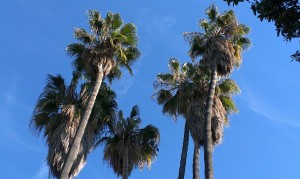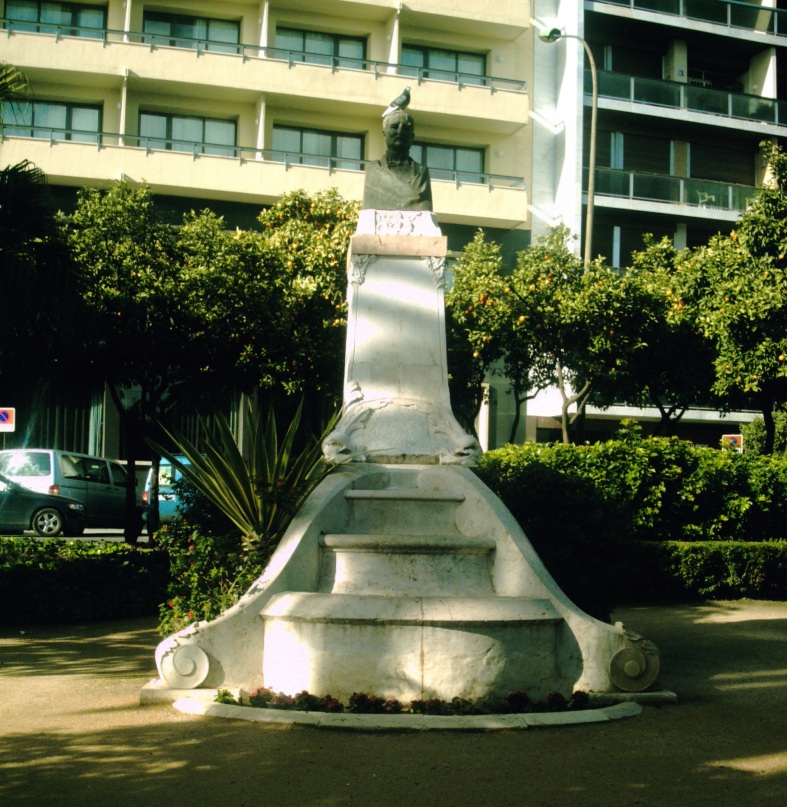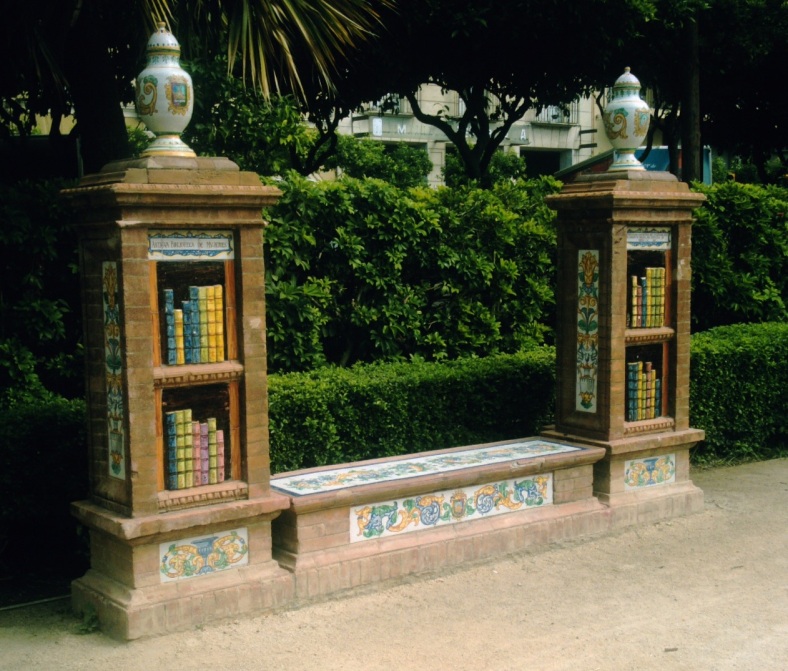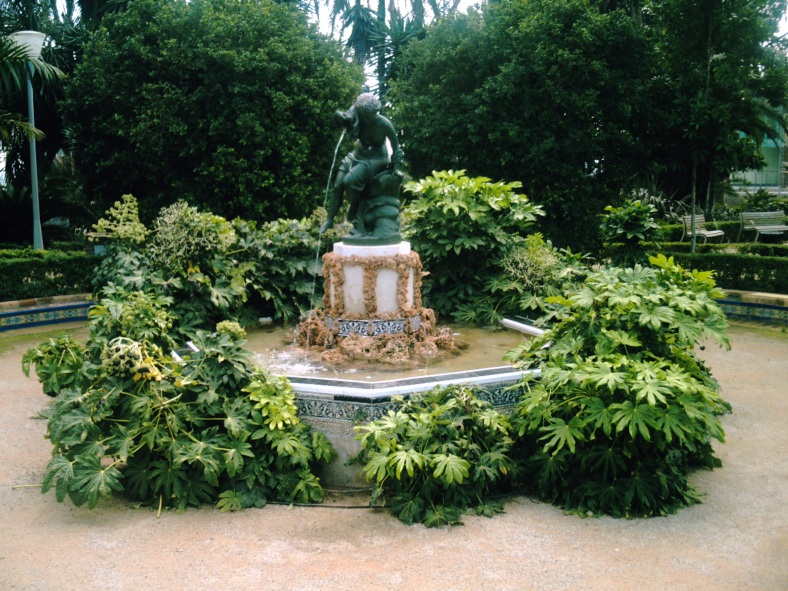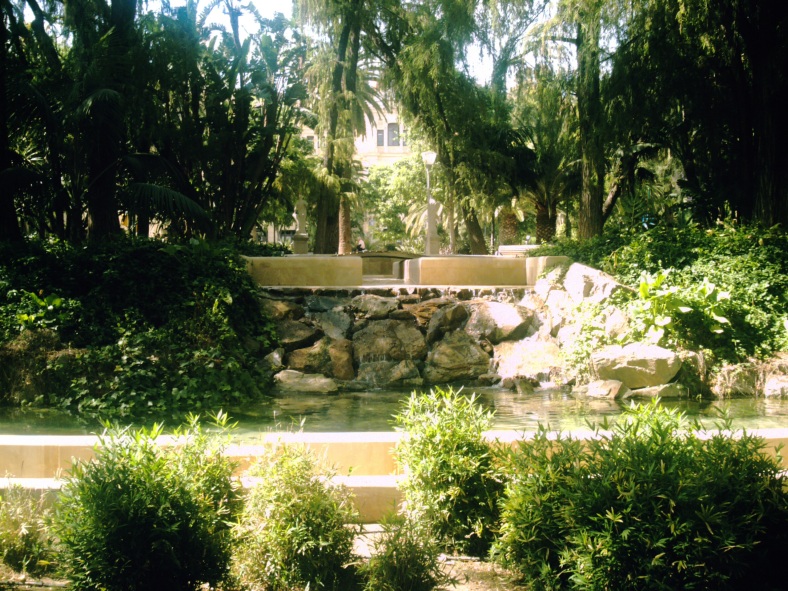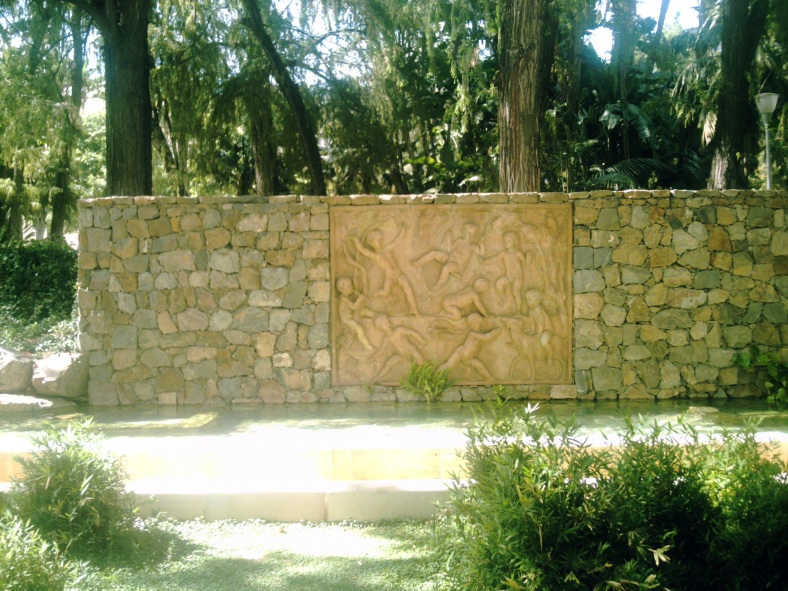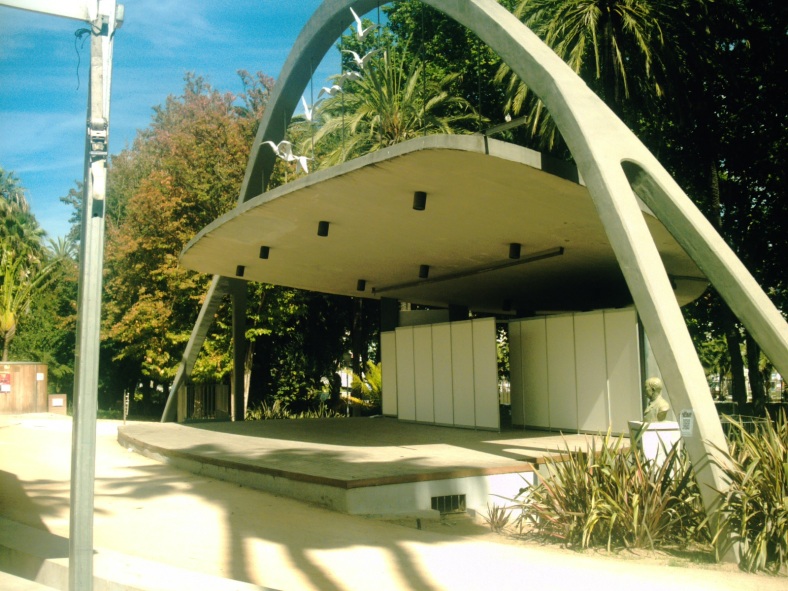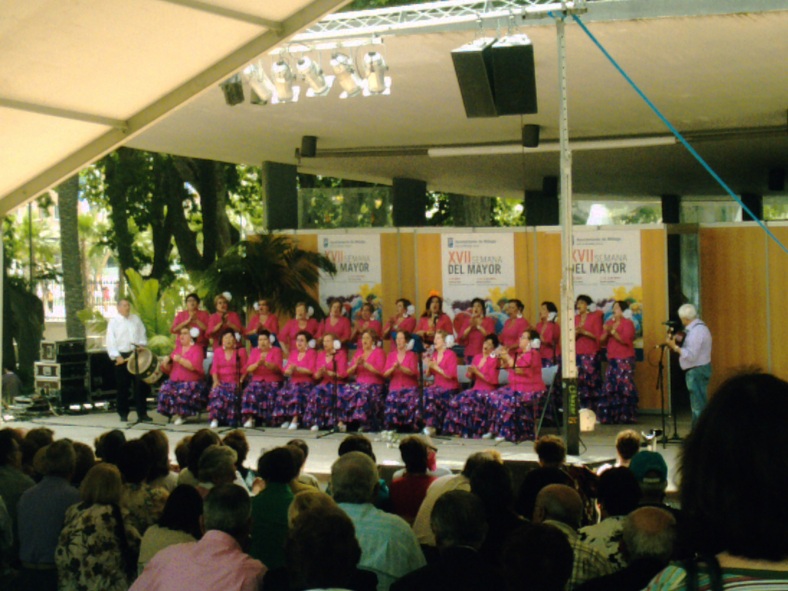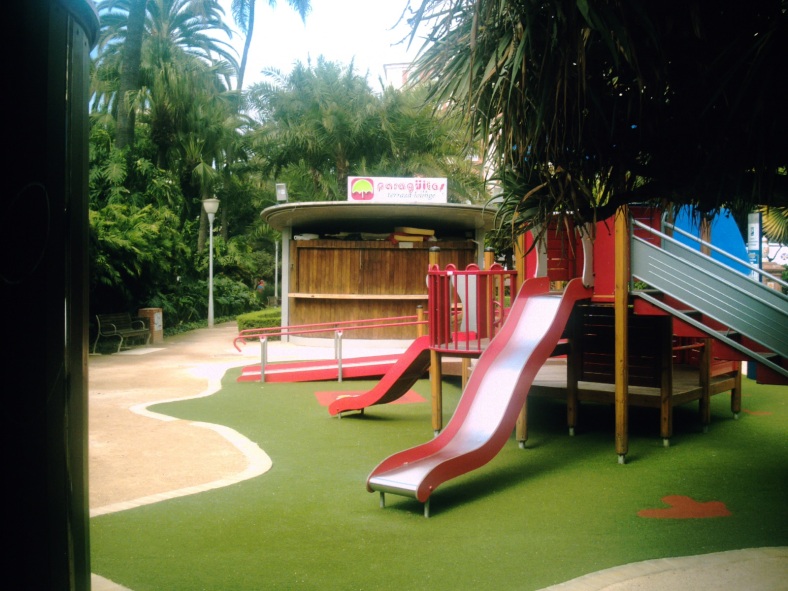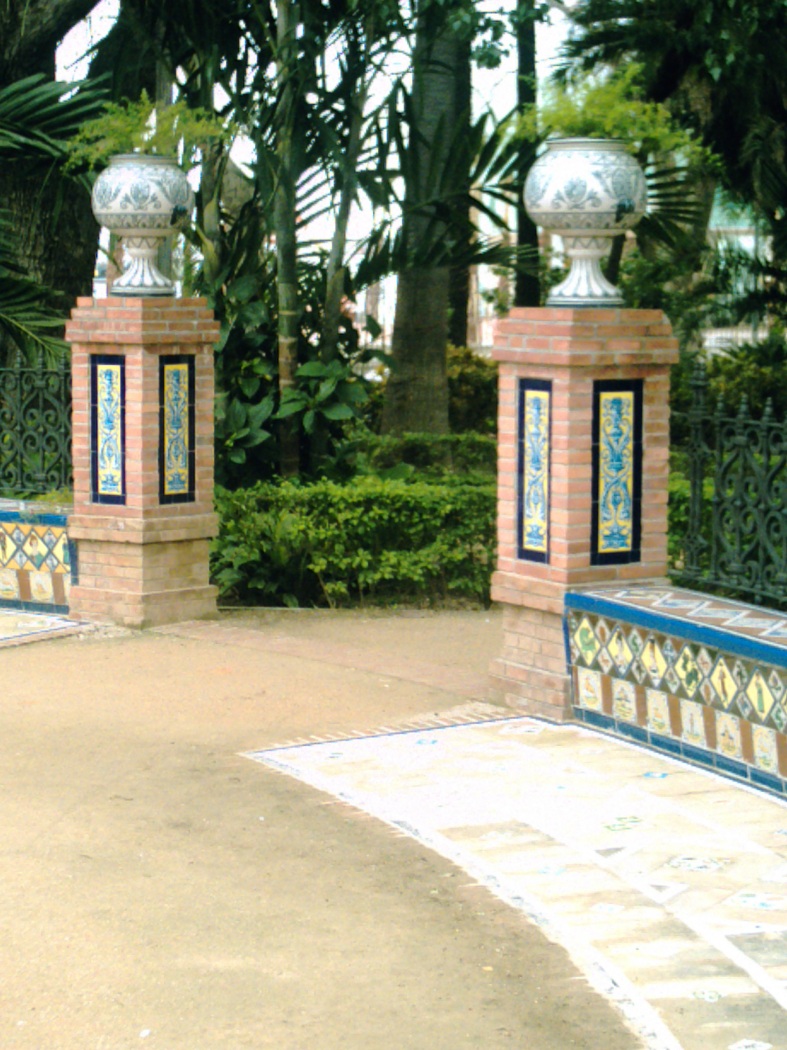A prominent feature of the Parque de Malaga are the numerous patios, fountains, sculptures and monuments which one encounters throughout, often hidden amongst the lush tropical foliage. There is a pond or estanque, with a waterfall area, two play areas with cafes, and of course the outdoor theatre area, which echoes nicely the discovery of an original Roman ampitheatre in the city in the 1950’s by the Alcazaba, less than a kilometre away.
Most of the statues have local history connections, whether poets, local politicians, military leaders, mythical figures. I will add more detail as I find out information on each.
A recurring theme is the use of the tile, or azulejo , in the decoration of patios and seating areas in the Parque. This of course is characteristic feature of much of Andalucian garden design.
Please see the MAP at the foot of this page detailing the location of all of the main features of interest (letters in red), alongside all of the plantings (numbers in black – see the Plant List section of this blog). Click on the image to see it full size.
BANDA INTERIOR. Smaller, inner section of the Parque.
((A) ARTURO REYES Writer. A 1970’s sculpture by Adrian Ruiseno (to confirm)
(B) MARQUES de GUARDIARO The construction of this statue was supported by the town hall and business community in Malaga. It’s author was the Catalan, Matheu Fernandez de Soto.
(C) BIBLIOTECA de MUJERES celebrating I believe, the history of a women’s library which used to exist in the Parque.
(D) COMMANDANTE BENITEZ. An impressive bronze statue and stone plinth by military artist Julio Gonzalez Pola (1926). Follows in that great tradition of Malaga statues, in that it was moved here from its original location in the city in the Plaza de la Marina (at the western end of the Parque). The figure is a tribute to Commandante Benitez who left Malaga port along with many others to fight in the Morrocco War in North Africa, and was considered a hero.
(E) NARCISCO DIAZ de ESCOVAR next to the Glorieta Romana (see below). This gentleman was a writer and diarist of Malaga life in the early 19th Century. The plinth (conjunto) was designed by Daniel Rubio, and the bust by Malagueno Juan Lopez.
(F) GLORIETA ROMANA surrounded by bamboo and palm plantings…
BANDA EXTERIOR Main section of the Parque.
(G) SALVADOR RUEDA statue, at the main western entrance to the park. Rueda was a poet, and the sculpture was designed in 1932 by his friend, Francisco Palma Garcia.
(H) BURRO PLATERO A small but popular silver coloured donkey statue seen in the play area…
(I) EL FIESTERO The first of three adjoining, circular patio areas next to the Paseo del Parque, approaching from the west…
(J) NINFA CON CARACOLA – Nymph with seashell – In the second patio area
(K) Statue and third patio area……I believe this was the location of the famous Biznaguero (Jasmine seller) statue but, as with other monuments in Malaga city this has been moved (it was originally in the Plaza de la Marina) and can now be found just across the road in Los Jardines de Pedro Luis Alonso….I believe the title for this statue is FUENTE DE LA NINFA CON CANTAO.
(L) MUÑOZ DEGRAIN bust, below, immediately before the theatre area. A former professor of the School of Arts (Escuela de Bellas Artes) and a sponsor and donator of a rich collection of artworks in the city. The statue was designed by Diego Garcia Carreras. Framed by towering Washingtonia palms, and flowering Deutzia x magnifica.
(M) ALEGORIA DE INVIERNO, ALEGORIA DE VERANO. Designed by Jose Vilches, two figures framing the entrance to the Estanque (pond) area (see photos below), with several Taxodium (Swamp Cypress) in the background. The famous water feature statue which used to dominate the centre of this pond can now be viewed in the city centre Plaza de la Constitution, at the top of Calle Larios.
The outer edge of the “estanque” looks like a step but is actually a channel, or rill (see photos above and below). The water overflows into this and then trickles down another channel to produce a small waterfall, (N) FUENTE DE LOS AMORCILLOS, which feeds another pond area next to the lower walkway and Paseo de los Curas. It is framed by an attractive terracotta mural feature. In terms of planting, Vinca, Hedera, Philodendron and Asparagus groundcover soften the area (See photos below).
(O) BERNARDO FERRANDIZ bust, below. Thought to be the first monument to be erected in the Parque. A popular painter from Valencia who came to Malaga to paint the ceiling of the Teatro Cervantes in the city. The surrounding planting includes Tetraclinis and Alocasia in the background, and Dracaena sanderiana block planting to the foreground.
(P) SAN FIACRE statue. The “Patron Saint of Gardeners !”, next to the lower walkway & Paseo de los Curas…
(Q) RUBEN DARIO statue at the far eastern end of the park. Hedera and Perlogonium groundcover to the front; Pinus canariensis and Monstera deliciosa visible in background.
(R) EDUARDO OCON Y RIVAS. A statue in the Theatre area, celebrating the life and work of a musician. Born in Benamocarra in the C19th, Eduardo studied in Madrid before going on to become the second director of the Philharmonic Society of Malaga.
Here’s the (S) Theatre area itself in the main section of the Park…
As mentioned, there are two Play Areas (T) for children and families in the Parque. At least one of the three original cafes is still open and, writing in 2013, the play areas themselves have been improved since my last visit in 2011. Here’s the one in the inner section…
(U) There is a small metal plaque at the western entrance to the Parque, celebrating its renovation and official re-opening to the public in the past few years. Just around the corner to this there used to be another marble obelisk (V) comemorating the ongoing campaign highlighting the problem of violence against women in Spain, but in 2014 it seems to have been removed, though I’ve included it on the map. Here’s the plaque..
It’s worth noting some of the other statues just a short walk away from the Parque, and I’ll add further details about these. As examples, the classic Fuente de las Tres Gracias in the centre of the roundabout (glorieta) by the bullring at the eastern end of the Paseo del Parque, and the statue commemorating important Malaga politician Canovas del Castillo, which once stood in one of the circular patio areas, but these days can be found nearby on the roadway by the bullring (del Castillo’s role is mentioned in the history section of this blog).
It’s also well worth taking a stroll around the beautiful buidings which run alongside the Paseo del Parque to the north, as these too are an integral part of the story of the area. As mentioned in the history section of this blog, several of these majestic looking buildings – the Town Hall (Ayuntamiento) Bank (Banco), and Post Office (Correos – although now part of the University) along with the “Casa del Jardinero,” (Gardener’s House) were designed and constructed in the early decades of the Parque’s existence. Others – such as the old Aduana or Customs House (now the proud home of the impressive Museo del Malaga, which has only recently been reconstructed and opened to the public) certainly pre date the Parque itself. I intend to add a separate page with photos dedicated to these buildings shortly.
Finally, here are some detailed photos of the traditional use of the Azulejo (tile) in the various patio areas in the Parque .
MAP OF PARQUE SHOWING MONUMENTS (and plantings, being updated January 2015).
